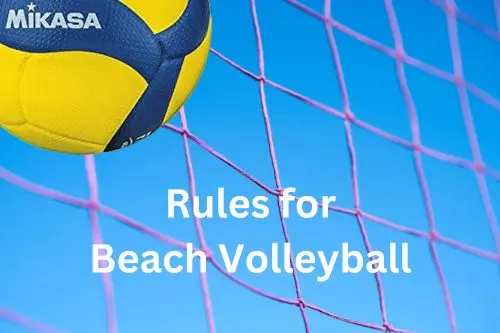Rules for Beach Volleyball

Rules for Beach Volleyball: A Complete Guide
Beach volleyball is an exciting, fast paced sport enjoyed by millions around the world. Whether you’re watching it during the Olympics or playing a casual match with friends on the sand, it’s important to understand the rules that govern the game. While it shares a common origin with indoor volleyball, beach volleyball has its own distinct set of rules that reflect its unique environment and style of play.
This article outlines the key rules of beach volleyball and explains the differences between beach and indoor volleyball to help players and fans better appreciate the nuances of the game.
Basic Rules of Beach Volleyball
Team Composition
Beach volleyball is typically played in teams of two players per side. Unlike indoor volleyball, there are no substitutions. Each player must cover a large area of the court, making conditioning and versatility essential.
The Court
The standard size of a beach volleyball court is 16 meters long and 8 meters wide, which is slightly smaller than an indoor volleyball court. There are no attack lines in beach volleyball; players can hit from anywhere on their side of the court.
The Net Height
The net height is the same as indoor volleyball:
- Men: 2.43 meters (7 feet 11 5/8 inches)
- Women: 2.24 meters (7 feet 4 1/8 inches)
Scoring System
Beach volleyball uses a rally scoring system, meaning a point is scored on every serve, regardless of which team served. Matches are played best of three sets:
- First two sets: First team to 21 points (must win by 2)
- Third set (if needed): First to 15 points (also must win by 2)
There is no cap, so a set continues until one team has a two point lead.
Serve and Rotation
Each player serves alternately, and there’s no rotational movement like in indoor volleyball. The server must stand behind the end line and can serve from anywhere along that line. Let serves (when the ball touches the net and lands in) are allowed.
Ball Touches
Each team is allowed up to three touches to return the ball over the net. These usually include a bump (pass), set and spike (attack hit). However, a block counts as one of the three touches in beach volleyball.
Players cannot open hand tip or “dink” the ball over the net. Instead, they must use a firm part of the hand or employ a clean, hard driven hit.
Ball Handling Rules
Ball handling rules are more strict in beach volleyball. For example:
- Hand sets must be clean, without any rotation. Double contacts (when the ball spins significantly) are more strictly enforced.
- Open hand digs are not allowed unless the ball is a hard driven attack.
- Lifting or carrying the ball is a fault.
These rules are enforced to encourage clean and athletic play.
Blocking
Blocking is legal, and a blocker may reach over the net as long as they don’t interfere with the opponent’s play. If the ball touches the block, it counts as the first touch, leaving only two more contacts for that team.
Switching Sides
To ensure fairness due to wind or sun, teams switch sides every 7 points in sets to 21 and every 5 points in a 15 point set.
Attire and Equipment
Beach volleyball is often played barefoot. Players wear minimal, sport specific attire for mobility and comfort in hot, sandy conditions. The ball used is slightly larger and lighter than an indoor ball, designed to float more in the wind and be easier to control in outdoor environments.
Key Differences Between Beach and Indoor Volleyball
While the two sports share similar fundamentals, the differences are significant enough that strategies and player roles vary greatly between formats.
Team Size and Substitutions
- Beach: 2 players per team; no substitutions.
- Indoor: 6 players per team; multiple substitutions allowed per set.
This difference requires beach players to be well rounded, handling all aspects of the game.
Court Size
- Beach: 8m x 16m, no attack line.
- Indoor: 9m x 18m, with a 3 meter attack line for back row players.
The smaller beach court is offset by having fewer players, which still demands high stamina and coverage ability.
Surface and Movement
- Beach: Played on sand, which slows movement and requires more physical exertion.
- Indoor: Played on a hard court, allowing quicker, more explosive movements.
This impacts jumping, diving and general footwork.
Ball Characteristics
- Beach: Lighter, softer and slightly larger; designed to handle wind and outdoor conditions.
- Indoor: Heavier and smaller; designed for speed and power.
Attire and Footwear
- Beach: Barefoot with lightweight attire.
- Indoor: Specialized court shoes and team uniforms.
Specialized Positions
- Beach: No specialization; both players perform all roles.
- Indoor: Specialized roles like setter, libero, outside hitter, middle blocker, etc.
Tactics and Strategy
Beach volleyball involves more tactical play due to the fewer number of players. There’s greater emphasis on communication, court vision and ball placement. Players often use hand signals behind their backs to indicate blocking or defensive strategies.
Indoor volleyball, with six players and faster pace, allows for more complex plays and formations, including back row attacks, quick sets and rotations.
Coaching
- Beach: Coaching during the match is not allowed (except during timeouts in certain events).
- Indoor: Coaches are actively involved throughout the match.
This places more responsibility on beach players to make strategic decisions themselves during play.
Conclusion
Beach volleyball is a thrilling sport that blends athleticism, strategy and endurance in a dynamic outdoor setting. Its rules are designed to accommodate the unique challenges of sand, wind and a two player team format. While it shares a heritage with indoor volleyball, the differences between the two sports make them distinct in both play style and competitive strategy.
Understanding the rules of beach volleyball not only enhances the playing experience but also deepens your appreciation for the skill and effort involved. Whether you’re a casual beachgoer looking to play a friendly match or an aspiring competitor, knowing the rules is the first step toward mastering the game.
So next time you’re on the sand, keep these rules in mind — and get ready to dive, spike and serve your way to victory!


